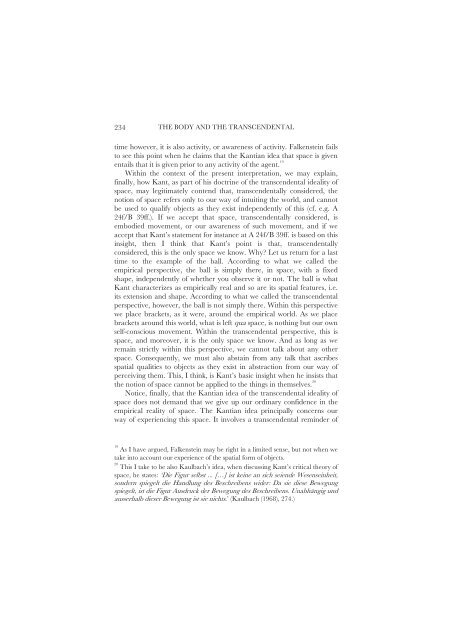BODY AND PRACTICE IN KANT
BODY AND PRACTICE IN KANT
BODY AND PRACTICE IN KANT
Create successful ePaper yourself
Turn your PDF publications into a flip-book with our unique Google optimized e-Paper software.
234<br />
THE <strong>BODY</strong> <strong>AND</strong> THE TRANSCENDENTAL<br />
time however, it is also activity, or awareness of activity. Falkenstein fails<br />
to see this point when he claims that the Kantian idea that space is given<br />
entails that it is given prior to any activity of the agent. 19<br />
Within the context of the present interpretation, we may explain,<br />
finally, how Kant, as part of his doctrine of the transcendental ideality of<br />
space, may legitimately contend that, transcendentally considered, the<br />
notion of space refers only to our way of intuiting the world, and cannot<br />
be used to qualify objects as they exist independently of this (cf. e.g. A<br />
24f/B 39ff.). If we accept that space, transcendentally considered, is<br />
embodied movement, or our awareness of such movement, and if we<br />
accept that Kant’s statement for instance at A 24f/B 39ff. is based on this<br />
insight, then I think that Kant’s point is that, transcendentally<br />
considered, this is the only space we know. Why? Let us return for a last<br />
time to the example of the ball. According to what we called the<br />
empirical perspective, the ball is simply there, in space, with a fixed<br />
shape, independently of whether you observe it or not. The ball is what<br />
Kant characterizes as empirically real and so are its spatial features, i.e.<br />
its extension and shape. According to what we called the transcendental<br />
perspective, however, the ball is not simply there. Within this perspective<br />
we place brackets, as it were, around the empirical world. As we place<br />
brackets around this world, what is left qua space, is nothing but our own<br />
self-conscious movement. Within the transcendental perspective, this is<br />
space, and moreover, it is the only space we know. And as long as we<br />
remain strictly within this perspective, we cannot talk about any other<br />
space. Consequently, we must also abstain from any talk that ascribes<br />
spatial qualities to objects as they exist in abstraction from our way of<br />
perceiving them. This, I think, is Kant’s basic insight when he insists that<br />
the notion of space cannot be applied to the things in themselves. 20<br />
Notice, finally, that the Kantian idea of the transcendental ideality of<br />
space does not demand that we give up our ordinary confidence in the<br />
empirical reality of space. The Kantian idea principally concerns our<br />
way of experiencing this space. It involves a transcendental reminder of<br />
19<br />
As I have argued, Falkenstein may be right in a limited sense, but not when we<br />
take into account our experience of the spatial form of objects.<br />
20<br />
This I take to be also Kaulbach’s idea, when discussing Kant’s critical theory of<br />
space, he states: ‘Die Figur selbst ... […] ist keine an sich seiende Wesenseinheit,<br />
sondern spiegelt die Handlung des Beschreibens wider: Da sie diese Bewegung<br />
spiegelt, ist die Figur Ausdruck der Bewegung des Beschreibens. Unabhängig und<br />
ausserhalb dieser Bewegung ist sie nichts.’ (Kaulbach (1968), 274.)
















